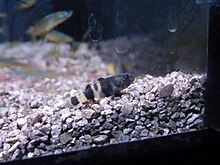Brachygobius is a small genus of gobies. They are popular aquarium fish where a number of species are sold as bumblebee gobies because their colours are similar to those of bumblebees.[1]
| Brachygobius | |
|---|---|

| |
| Bumblebee Fish (B. xanthozonus) | |
| Scientific classification | |
| Domain: | Eukaryota |
| Kingdom: | Animalia |
| Phylum: | Chordata |
| Class: | Actinopterygii |
| Order: | Gobiiformes |
| Family: | Oxudercidae |
| Subfamily: | Gobionellinae |
| Genus: | Brachygobius Bleeker, 1874 |
| Type species | |
| Gobius doriae Günther, 1868
| |
| Synonyms | |
| |
Morphology
editBumblebee gobies range in size from 1.5 cm to 4 cm.[2] They are generally coloured black with pale yellow to orange bands.[3] Males are generally slimmer than females and often have more vivid colours, typically orange rather than yellow.[3] Females may also have smaller and rounder heads.[2] When spawning, the colours of the males become deeper, the orange bands becoming red in the case of Brachygobius doriae.[2]
Taxonomy
editThis genus is informally divided by taxonomists into the dwarf Brachygobius nunus-species group (e.g., B. nunus, B. aggregatus, and B. mekongensis) and the bigger Brachygobius doriae-species group (e.g., B. doriae, B. sabanus, and B. xanthomelas).[2]
Species
editThere are currently nine recognized species in this genus:[4]
- Brachygobius aggregatus Herre, 1940 (Schooling bumblebee goby)
- Brachygobius doriae (Günther, 1868) (Bumblebee goby)
- Brachygobius kabiliensis Inger, 1958 (Kabili bumblebee goby)
- Brachygobius mekongensis Larson & Vidthayanon, 2000
- Brachygobius nunus (F. Hamilton, 1822)
- Brachygobius sabanus Inger, 1958
- Brachygobius sua (H. M. Smith, 1931)
- Brachygobius xanthomelas Herre, 1937
- Brachygobius xanthozonus (Bleeker, 1849) (Bumblebee fish)
Ecology
editBumblebee gobies are found across Southern and Southeast Asia primarily in freshwater habitats but also in slightly brackish waters.[2][3]
Reproduction
editThese gobies are oviparous. Eggs are deposited in a cave where they are guarded by the male.[3] Clutch size is around 150–200 eggs.[5] The eggs hatch after around seven days and the fry become free swimming another five to seven days later.[3]
In the aquarium
editBumblebee gobies are popular aquarium fish.[5] A tank around 40 liters in size will house a dozen specimens comfortably. Under good conditions, they can live in an aquarium for around 5 years.[3] The most commonly traded species in the hobby belong to the Brachygobius doriae-species group but the smaller Brachygobius nunus is also traded occasionally.[2][3] Although many aquarium books use the name Brachygobius xanthozona, this species is very rare in the wild and is not commercially traded.[3]
References
edit- ^ Fenner, Robert. "Fresh to Brackish Water Gobioids". Retrieved 2007-05-21.
- ^ a b c d e f Schäfer F: Brackish Water Fishes, pp 49–51, Aqualog 2005, ISBN 3-936027-82-X
- ^ a b c d e f g h Naomi Delventhal in Monks, Neale (2006): Brackish Water Fishes, pp 131–132, TFH Publishing. ISBN 0-7938-0564-3
- ^ Froese, Rainer; Pauly, Daniel (eds.). "Species in genus Brachygobius". FishBase. April 2013 version.
- ^ a b Riehl R. & Baensch H: Aquarium Atlas (vol. 1), pp 836–837, Voyageur Press, 1996, ISBN 3-88244-050-3